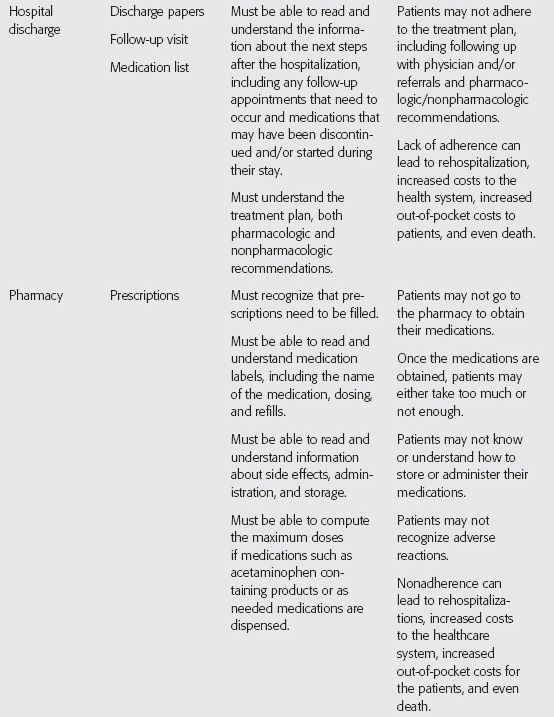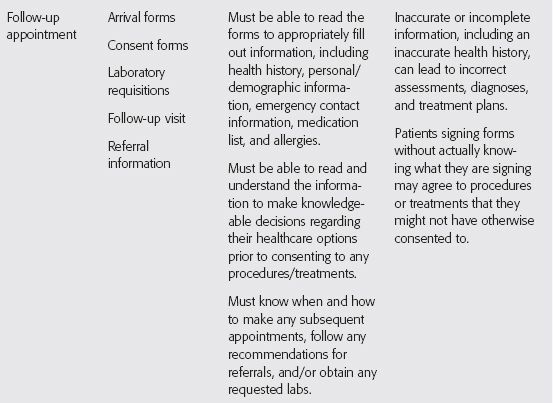Information literacy is the ability to obtain and apply health information. Patients need to know how to obtain and apply the information necessary to make informed health decisions. For example, a patient should know how or who to ask about side effects of a medication or know what to do if a side effect occurs. As another example, a patient must understand that certain medications, such as drugs for hypertension or hyperlipidemia, are chronic medications, meaning that refills need to occur on regular basis. A patient who does not have adequate information literacy may not understand that refills are required and that he is supposed to continue to take the medication beyond the 30-day supply in the bottle.
Numeric/computational literacy is the ability to calculate or apply mathematical skills. For instance, the directions for acetaminophen 500 mg state to take one to two tablets every 4 to 6 hours as needed for pain and not to exceed 3 grams in 24 hours. A patient must be computationally literate in order to determine the maximum number of tablets of acetaminophen that may be taken in a day to prevent adverse effects.
Pharmacists provide information in a variety of settings under the assumption that patients have adequate health literacy skills. However, pharmacists must evaluate the health literacy of each patient they encounter so that the communication session can be designed to meet that particular patient’s unique needs. One way to approach patients, especially when their level of health literacy is unknown, is to apply three universal precautions, which are general principles to use with all patient encounters since we do not know the risk of health literacy by simply looking at the patient. This is similar to the use of general precautions when dealing with bloodborne pathogens in that because we do not know who is at risk of bloodborne diseases, we have to develop standards to minimize the risk for everyone.11
1. You cannot tell a person’s health literacy level by looking. It is not possible to assess a patient’s health literacy based solely on the patient’s appearance. Thus, you should utilize appropriate communication skills with every patient. After you have interacted with the patient and assessed his or her health literacy, you can tailor your interactions accordingly.
2. Communicate clearly with everyone. Using good communication skills, including using simple terminology, with all of your patients will lead to better patient understanding.
3. Confirm that the patient understands what you are saying. Communication is a two-way street. Make sure to assess that the patient understands what has been discussed. In general, asking a patient “Do you understand?” is not the best way to assess understanding, because close-ended questions limit the patient to answering with a yes or no. By asking open-ended questions, you can ascertain what the patient actually understands and assess whether it was the message you intended to give the patient.
A good way to confirm a patient’s understanding is to use the teach-back method. The teach-back method involves the following steps:
1. Explain the information to the patient. If a drug-delivery product is being explained, demonstrate its use. For example, if a patient is receiving an inhaler, teach the patient how to use it by actually going through the steps with the inhaler rather than just offering a verbal explanation.
2. Assess the patient’s understanding by asking the patient to repeat the key points of the information that has been presented.
3. Ask the patient to discuss the information or show you the technique he or she has just learned. If the explanation involves a device, ask the patient to demonstrate how to use it.
4. Actively listen to the patient to ensure that the patient actually understands the information that has been conveyed. If there is any misinterpretation or lack of understanding from the patient, correct or clarify the information.
5. Reassess the patient’s understanding, essentially repeating step 2.
6. Repeat steps 3–5 until it is clear that the patient understands the information.
Stay updated, free articles. Join our Telegram channel

Full access? Get Clinical Tree




